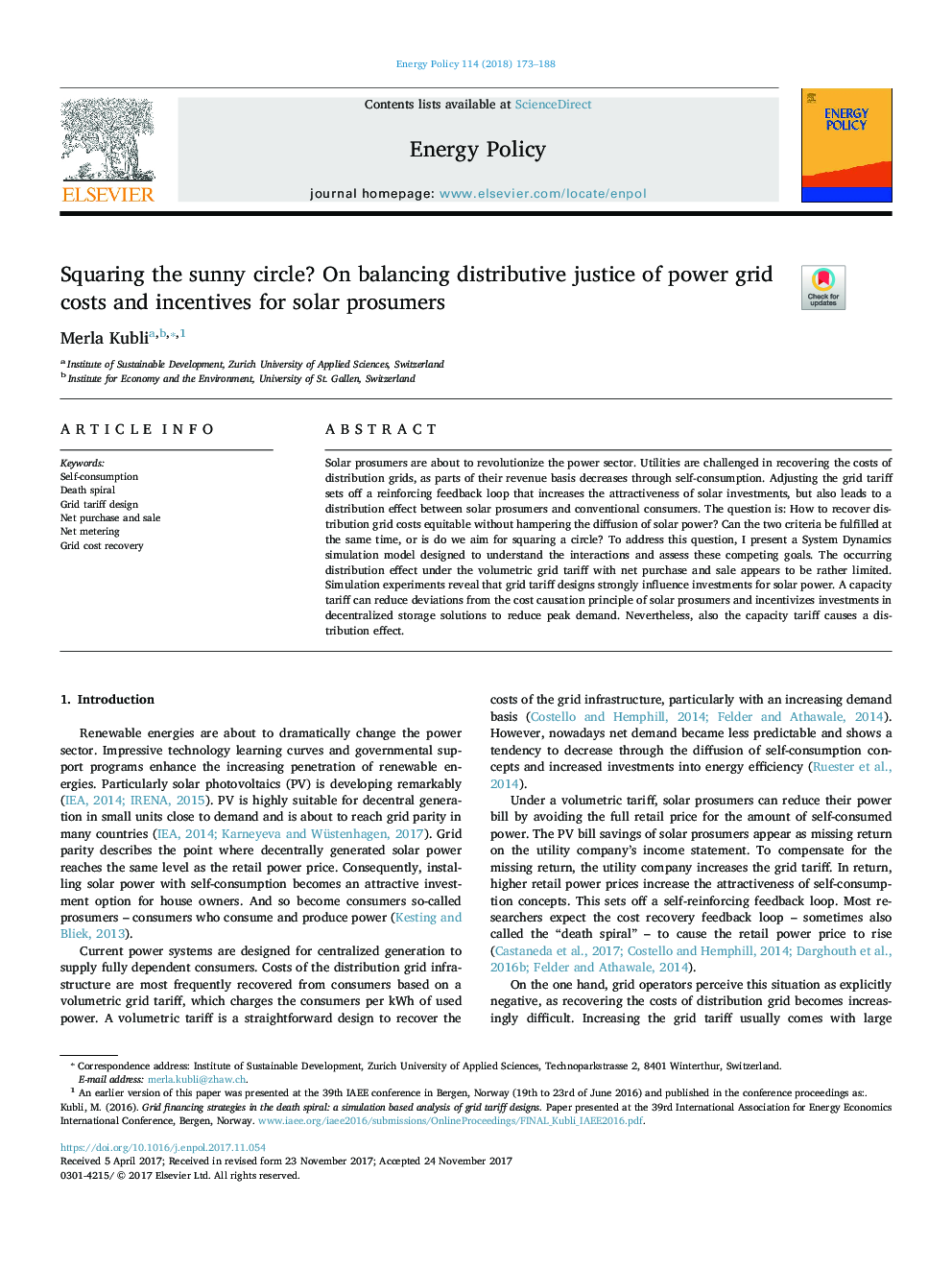| کد مقاله | کد نشریه | سال انتشار | مقاله انگلیسی | نسخه تمام متن |
|---|---|---|---|---|
| 7397592 | 1481244 | 2018 | 16 صفحه PDF | دانلود رایگان |
عنوان انگلیسی مقاله ISI
Squaring the sunny circle? On balancing distributive justice of power grid costs and incentives for solar prosumers
ترجمه فارسی عنوان
محاصره دایره آفتابی؟ بر عدالت توزیع متعادل کننده هزینه های شبکه برق و انگیزه های خورشیدی
دانلود مقاله + سفارش ترجمه
دانلود مقاله ISI انگلیسی
رایگان برای ایرانیان
کلمات کلیدی
خود مصرف، مارپیچ مرگ، طرح تعرفه شبکه، خرید و فروش خالص، اندازه گیری خالص هزینه بازیابی شبکه،
ترجمه چکیده
در حال حاضر خورشیدی در حال تبدیل شدن به بخش انرژی است. در هزینه های شبکه های توزیع، هزینه های آب و برق در معرض تهدید قرار می گیرند، چرا که بخشی از درآمد آنها از طریق مصرف خود کاهش می یابد. تنظیم تعرفه شبکه، یک چرخه بازخورد تقویت کننده را فراهم می کند که جذابیت سرمایه گذاری های خورشیدی را افزایش می دهد، بلکه منجر به تأثیر توزیع میان خورشید و مصرف کنندگان معمولی می شود. سوال این است: چگونه می توان هزینه های شبکه توزیع را عادلانه نگه داشت بدون اینکه مانع انتشار انرژی خورشیدی شود؟ آیا می توان دو معیار را در یک زمان انجام داد یا آیا ما برای مقابله با یک دایره تلاش می کنیم؟ برای پاسخگویی به این سؤال، من یک مدل شبیه سازی دینامیکی سیستم ارائه می دهم که برای درک متقابل و ارزیابی این اهداف رقابتی طراحی شده است. به نظر می رسد اثر توزیع بر اساس مقادیر شبکه حجمی با خرید و فروش خالص محدود و محدود نیست. آزمایشات شبیه سازی نشان می دهد که طرح های تعرفه شبکه به شدت بر سرمایه گذاری برای انرژی خورشیدی تاثیر می گذارد. تعرفه ظرفیت می تواند انحراف از اصل عددی هزینه های خورشیدی را کاهش دهد و سرمایه گذاری در راه حل های ذخیره سازی غیر متمرکز را کاهش دهد تا تقاضای پیک را کاهش دهد. با این وجود، تعرفه ظرفیت باعث تأثیر توزیع می شود.
موضوعات مرتبط
مهندسی و علوم پایه
مهندسی انرژی
مهندسی انرژی و فناوری های برق
چکیده انگلیسی
Solar prosumers are about to revolutionize the power sector. Utilities are challenged in recovering the costs of distribution grids, as parts of their revenue basis decreases through self-consumption. Adjusting the grid tariff sets off a reinforcing feedback loop that increases the attractiveness of solar investments, but also leads to a distribution effect between solar prosumers and conventional consumers. The question is: How to recover distribution grid costs equitable without hampering the diffusion of solar power? Can the two criteria be fulfilled at the same time, or is do we aim for squaring a circle? To address this question, I present a System Dynamics simulation model designed to understand the interactions and assess these competing goals. The occurring distribution effect under the volumetric grid tariff with net purchase and sale appears to be rather limited. Simulation experiments reveal that grid tariff designs strongly influence investments for solar power. A capacity tariff can reduce deviations from the cost causation principle of solar prosumers and incentivizes investments in decentralized storage solutions to reduce peak demand. Nevertheless, also the capacity tariff causes a distribution effect.
ناشر
Database: Elsevier - ScienceDirect (ساینس دایرکت)
Journal: Energy Policy - Volume 114, March 2018, Pages 173-188
Journal: Energy Policy - Volume 114, March 2018, Pages 173-188
نویسندگان
Merla Kubli,
